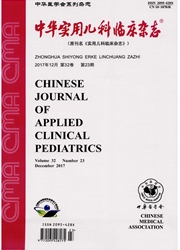

 中文摘要:
中文摘要:
目的探讨不同胎龄早产儿支气管肺发育不良(BPD)的影响因素。方法回顾性分析2011年1月1日至2015年12月31日在四川大学华西第二医院住院确诊为BPD的118例早产儿病历资料。根据胎龄分为超早早产儿组(〈28周)、极早早产儿组(28~31周)及晚期早产儿组(32~36周),分析不同胎龄的BPD患儿在妊娠期并发症、产前激素使用、性别、生产方式、用药等方面的差异。结果118例患儿中超早早产儿18例,极早早产儿82例,晚期早产儿18例;男婴71例,女婴47例;出生体质量≤1000g27例,〉1000~1500g70例,〉1500~2000g15例,〉2000g6例。在不同胎龄BPD患儿中,超早早产儿组全程使用持续正压通气9例,显著多于晚期早产儿(2例),差异有统计学意义(χ2=6.415,P=0.011)。母亲妊娠合并子痫前期对晚期早产儿组患儿的影响较超早早产儿组(χ2=4.018,P=0.045)及极早早产儿组(χ2=4.878,P=0.027)大;母亲妊娠合并子痫前期对超早早产儿组及极早早产儿组的影响差异无统计学意义(χ2=0.279,P=0.597)。超早早产儿组总吸氧时间[(56.56±29.58)d]较极早早产儿组[(43.15±14.86)d]及晚期早产儿组[(37.75±16.87)d]显著增加,差异有统计学意义(F=8.185,P=0.000)。超早早产儿组住院时间[(56.56±29.58)d]较极早早产儿组[(46.23±14.04)d]及晚期早产儿组[(39.06±29.81)d]显著增加,差异有统计学意义(F=5.606,P=0.004)。结论超早早产儿及极早早产儿患BPD的例数较晚期早产儿显著增加。胎龄本身是BPD发生的高危因素,所以应尽量延迟孕周。预防超早早产及极早早产、避免宫内缺氧及合理用氧是预防早产儿BPD发生及减少住院时间的重要措施。
 英文摘要:
英文摘要:
Objective To explore the influence factors for bronchopulmonary dysplasia(BPD) in different ges- tational age preterm infants. Methods The medical records of 118 premature infants who were diagnosed as BPD at West China Second Hospital, Sichuan University from January 1,2011 to December 31,2015 were retrospectively ana- lyzed. According to the gestational age, the premature infants were divided into extremely - early - premature infants group ( 〈 28 weeks) , very - early - premature infants group (28 - 31 weeks) and late - premature infants group (32 - 36 weeks). The differences in pregnancy complications, the use of glueocorticoids before delivery, gender, mode of produc- tion,medication for preterm infants with different gestational age preterm infants were analyzed. Results One hundred and eighteen preterm infants included 18 extremely - early - premature infants, 82 very - early - premature infants, and 18 late - preterm infants ;71 baby boys and 47 baby girls, with birth weight ≤ 1 000 g in 27 eases, 1 000 - 1 500 g in 70 cases,1 500 -2 000 g in 15 cases,and 〉2 000 g in 6 cases. There was a statistically significant difference as for the full use of continuous positive airway pressure between the extremely - early - premature infants group (9 cases) and the late -preterm infants group (2 cases) (χ2 = 6.415,P = 0.011 ). The late -preterm infants group whose mothers ex- perienced preeclampsia were more seriously affect than extremely - early premature infants group (χ2 = 4. 018, P = 0. 045 ) and very - early - premature infants group (χ2 = 4. 878, P = 0. 027 ), and there was no statistically significant difference between extremely- early- premature infants group and very- early -premature infants group(χ2 = 0.279, P = 0. 597 ). A significantly increased total oxygen duration was observed in extremely - early - premature infants group [ (56.56 ±29.58) d] compared with very -early -premature infants group[ (43.15 ± 14.86) d] and late - preterm - infant
 同期刊论文项目
同期刊论文项目
 同项目期刊论文
同项目期刊论文
 期刊信息
期刊信息
